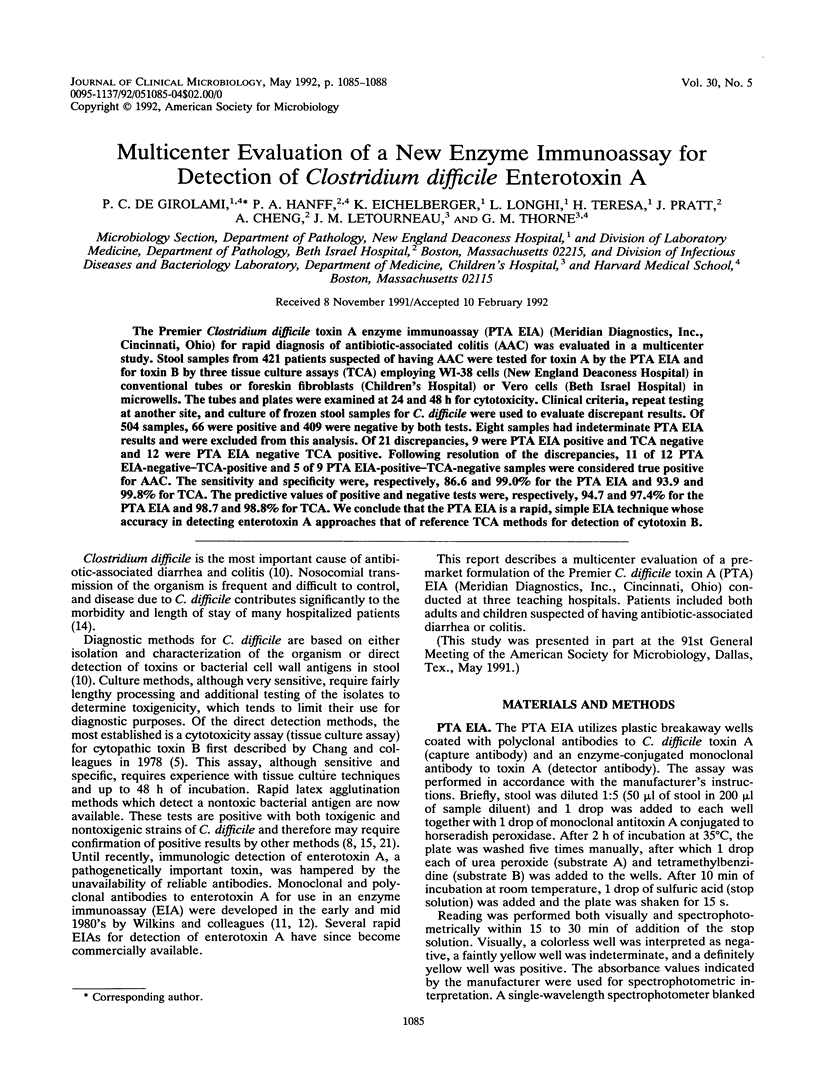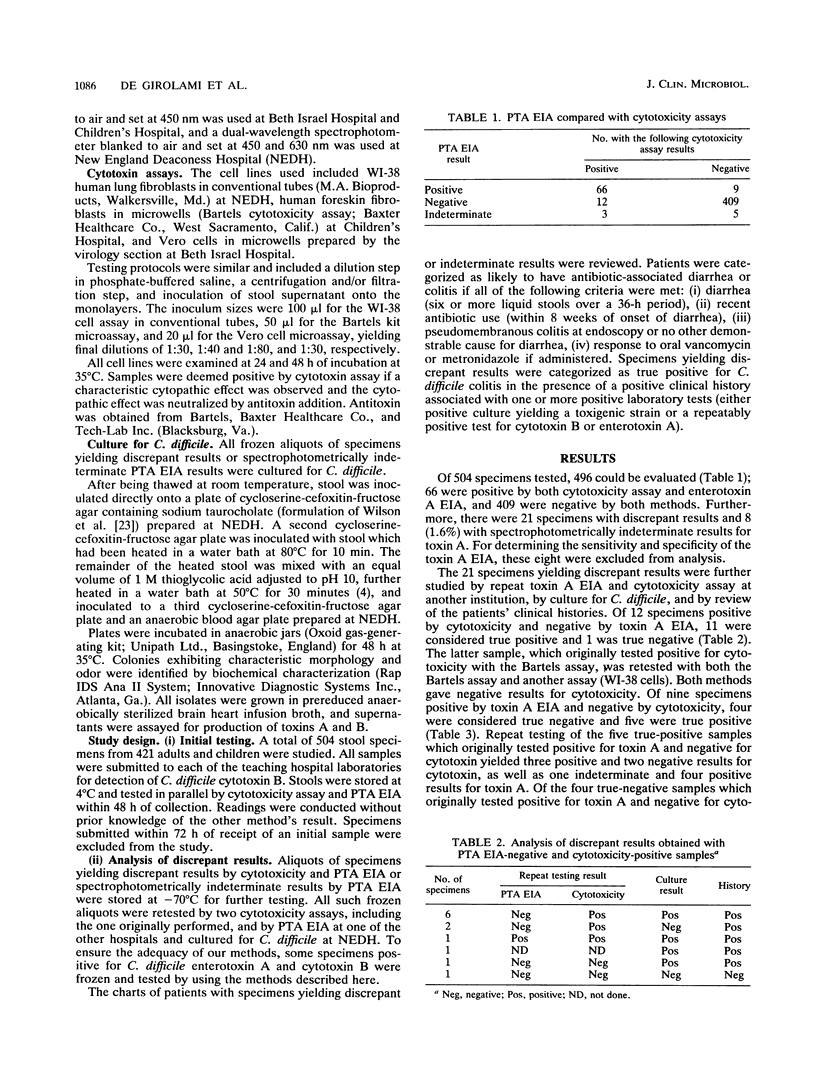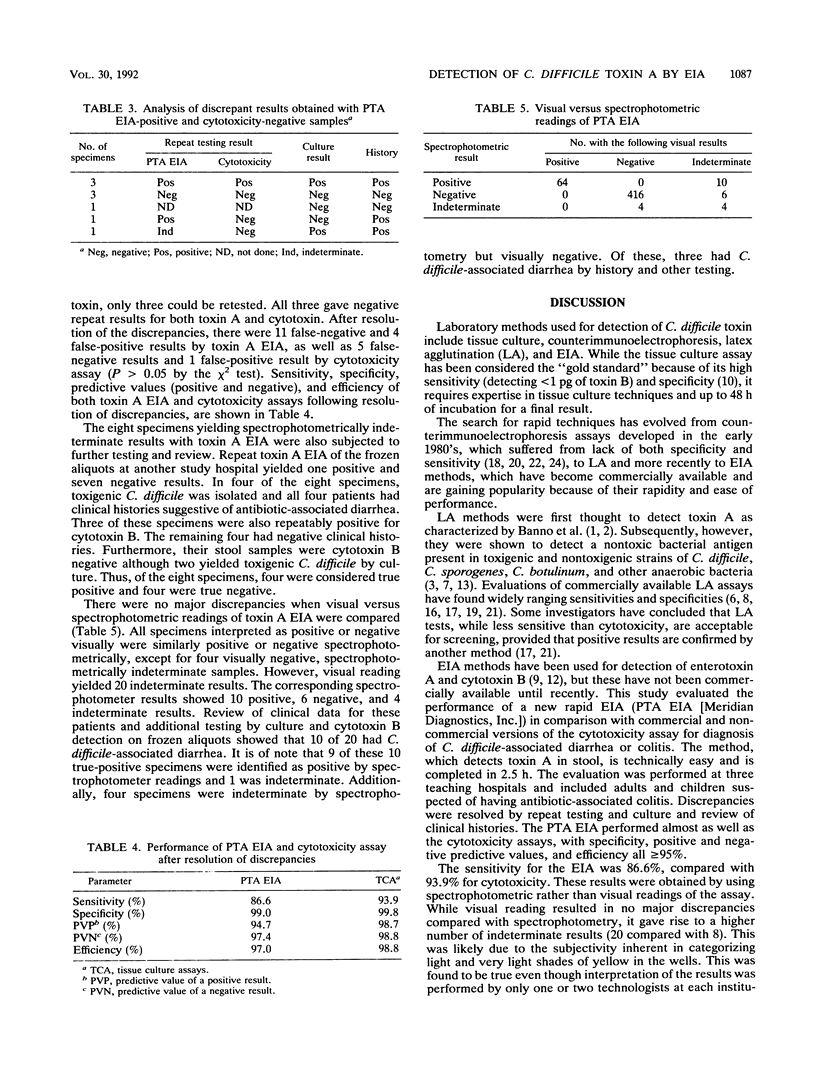Abstract
The Premier Clostridium difficile toxin A enzyme immunoassay (PTA EIA) (Meridian Diagnostics, Inc., Cincinnati, Ohio) for rapid diagnosis of antibiotic-associated colitis (AAC) was evaluated in a multicenter study. Stool samples from 421 patients suspected of having AAC were tested for toxin A by the PTA EIA and for toxin B by three tissue culture assays (TCA) employing WI-38 cells (New England Deaconess Hospital) in conventional tubes or foreskin fibroblasts (Children's Hospital) or Vero cells (Beth Israel Hospital) in microwells. The tubes and plates were examined at 24 and 48 h for cytotoxicity. Clinical criteria, repeat testing at another site, and culture of frozen stool samples for C. difficile were used to evaluate discrepant results. Of 504 samples, 66 were positive and 409 were negative by both tests. Eight samples had indeterminate PTA EIA results and were excluded from this analysis. Of 21 discrepancies, 9 were PTA EIA positive and TCA negative and 12 were PTA EIA negative TCA positive. Following resolution of the discrepancies, 11 of 12 PTA EIA-negative-TCA-positive and 5 of 9 PTA EIA-positive-TCA-negative samples were considered true positive for AAC. The sensitivity and specificity were, respectively, 86.6 and 99.0% for the PTA EIA and 93.9 and 99.8% for TCA. The predictive values of positive and negative tests were, respectively, 94.7 and 97.4% for the PTA EIA and 98.7 and 98.8% for TCA. We conclude that the PTA EIA is a rapid, simple EIA technique whose accuracy in detecting enterotoxin A approaches that of reference TCA methods for detection of cytotoxin B.
Full text
PDF



Selected References
These references are in PubMed. This may not be the complete list of references from this article.
- Banno Y., Kobayashi T., Kono H., Watanabe K., Ueno K., Nozawa Y. Biochemical characterization and biologic actions of two toxins (D-1 and D-2) from Clostridium difficile. Rev Infect Dis. 1984 Mar-Apr;6 (Suppl 1):S11–S20. doi: 10.1093/clinids/6.supplement_1.s11. [DOI] [PubMed] [Google Scholar]
- Borriello S. P., Barclay F. E., Reed P. J., Welch A. R., Brown J. D., Burdon D. W. Analysis of latex agglutination test for Clostridium difficile toxin A (D-1) and differentiation between C difficile toxins A and B and latex reactive protein. J Clin Pathol. 1987 May;40(5):573–580. doi: 10.1136/jcp.40.5.573. [DOI] [PMC free article] [PubMed] [Google Scholar]
- Chang T. W., Gorbach S. L., Bartlett J. B. Neutralization of Clostridium difficile toxin by Clostridium sordellii antitoxins. Infect Immun. 1978 Nov;22(2):418–422. doi: 10.1128/iai.22.2.418-422.1978. [DOI] [PMC free article] [PubMed] [Google Scholar]
- Kamiya S., Nakamura S., Yamakawa K., Nishida S. Evaluation of a commercially available latex immunoagglutination test kit for detection of Clostridium difficile D-1 toxin. Microbiol Immunol. 1986;30(2):177–181. doi: 10.1111/j.1348-0421.1986.tb00932.x. [DOI] [PubMed] [Google Scholar]
- Kelly M. T., Champagne S. G., Sherlock C. H., Noble M. A., Freeman H. J., Smith J. A. Commercial latex agglutination test for detection of Clostridium difficile-associated diarrhea. J Clin Microbiol. 1987 Jul;25(7):1244–1247. doi: 10.1128/jcm.25.7.1244-1247.1987. [DOI] [PMC free article] [PubMed] [Google Scholar]
- Laughon B. E., Viscidi R. P., Gdovin S. L., Yolken R. H., Bartlett J. G. Enzyme immunoassays for detection of Clostridium difficile toxins A and B in fecal specimens. J Infect Dis. 1984 May;149(5):781–788. doi: 10.1093/infdis/149.5.781. [DOI] [PubMed] [Google Scholar]
- Lyerly D. M., Krivan H. C., Wilkins T. D. Clostridium difficile: its disease and toxins. Clin Microbiol Rev. 1988 Jan;1(1):1–18. doi: 10.1128/cmr.1.1.1. [DOI] [PMC free article] [PubMed] [Google Scholar]
- Lyerly D. M., Phelps C. J., Wilkins T. D. Monoclonal and specific polyclonal antibodies for immunoassay of Clostridium difficile toxin A. J Clin Microbiol. 1985 Jan;21(1):12–14. doi: 10.1128/jcm.21.1.12-14.1985. [DOI] [PMC free article] [PubMed] [Google Scholar]
- Lyerly D. M., Sullivan N. M., Wilkins T. D. Enzyme-linked immunosorbent assay for Clostridium difficile toxin A. J Clin Microbiol. 1983 Jan;17(1):72–78. doi: 10.1128/jcm.17.1.72-78.1983. [DOI] [PMC free article] [PubMed] [Google Scholar]
- Lyerly D. M., Wilkins T. D. Commercial latex test for Clostridium difficile toxin A does not detect toxin A. J Clin Microbiol. 1986 Mar;23(3):622–623. doi: 10.1128/jcm.23.3.622-623.1986. [DOI] [PMC free article] [PubMed] [Google Scholar]
- McFarland L. V., Mulligan M. E., Kwok R. Y., Stamm W. E. Nosocomial acquisition of Clostridium difficile infection. N Engl J Med. 1989 Jan 26;320(4):204–210. doi: 10.1056/NEJM198901263200402. [DOI] [PubMed] [Google Scholar]
- Miles B. L., Siders J. A., Allen S. D. Evaluation of a commercial latex test for Clostridium difficile for reactivity with C. difficile and cross-reactions with other bacteria. J Clin Microbiol. 1988 Nov;26(11):2452–2455. doi: 10.1128/jcm.26.11.2452-2455.1988. [DOI] [PMC free article] [PubMed] [Google Scholar]
- Peterson L. R., Holter J. J., Shanholtzer C. J., Garrett C. R., Gerding D. N. Detection of Clostridium difficile toxins A (enterotoxin) and B (cytotoxin) in clinical specimens. Evaluation of a latex agglutination test. Am J Clin Pathol. 1986 Aug;86(2):208–211. doi: 10.1093/ajcp/86.2.208. [DOI] [PubMed] [Google Scholar]
- Peterson L. R., Olson M. M., Shanholtzer C. J., Gerding D. N. Results of a prospective, 18-month clinical evaluation of culture, cytotoxin testing, and culturette brand (CDT) latex testing in the diagnosis of Clostridium difficile-associated diarrhea. Diagn Microbiol Infect Dis. 1988 Jun;10(2):85–91. doi: 10.1016/0732-8893(88)90045-4. [DOI] [PubMed] [Google Scholar]
- Poxton I. R., Byrne M. D. Detection of Clostridium difficile toxin by counterimmunoelectrophoresis: a note of caution. J Clin Microbiol. 1981 Sep;14(3):349–349. doi: 10.1128/jcm.14.3.349-349.1981. [DOI] [PMC free article] [PubMed] [Google Scholar]
- Ryan R. W., Kwasnik I., Clout D., Tilton R. C. Utility of a rapid latex test for the detection of Clostridium difficile in fecal specimens. Ann Clin Lab Sci. 1987 Jul-Aug;17(4):232–235. [PubMed] [Google Scholar]
- Sands M., Yungbluth M., Sommers H. M. The non-value of counterimmunoelectrophoresis for the direct rapid detection of Clostridium difficile toxin in stool filtrates. Am J Clin Pathol. 1983 Mar;79(3):375–377. doi: 10.1093/ajcp/79.3.375. [DOI] [PubMed] [Google Scholar]
- Sherman M. E., DeGirolami P. C., Thorne G. M., Kimber J., Eichelberger K. Evaluation of a latex agglutination test for diagnosis of Clostridium difficile-associated colitis. Am J Clin Pathol. 1988 Feb;89(2):228–233. doi: 10.1093/ajcp/89.2.228. [DOI] [PubMed] [Google Scholar]
- West S. E., Wilkins T. D. Problems associated with counterimmunoelectrophoresis assays for detecting Clostridium difficile toxin. J Clin Microbiol. 1982 Feb;15(2):347–349. doi: 10.1128/jcm.15.2.347-349.1982. [DOI] [PMC free article] [PubMed] [Google Scholar]
- Wilson K. H., Kennedy M. J., Fekety F. R. Use of sodium taurocholate to enhance spore recovery on a medium selective for Clostridium difficile. J Clin Microbiol. 1982 Mar;15(3):443–446. doi: 10.1128/jcm.15.3.443-446.1982. [DOI] [PMC free article] [PubMed] [Google Scholar]
- Wu T. C., Fung J. C. Evaluation of the usefulness of counterimmunoelectrophoresis for diagnosis of Clostridium difficile-associated colitis in clinical specimens. J Clin Microbiol. 1983 Apr;17(4):610–613. doi: 10.1128/jcm.17.4.610-613.1983. [DOI] [PMC free article] [PubMed] [Google Scholar]


